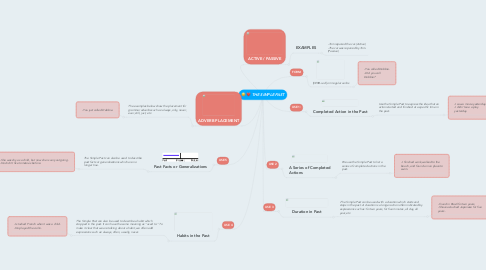
1. USE 4
1.1. Habits in the Past
1.1.1. The Simple Past can also be used to describe a habit which stopped in the past. It can have the same meaning as "used to." To make it clear that we are talking about a habit, we often add expressions such as: always, often, usually, never.
1.1.1.1. -I studied French when I was a child. -He played the violin.
2. USE 5
2.1. Past Facts or Generalizations
2.1.1. The Simple Past can also be used to describe past facts or generalizations which are no longer true.
2.1.1.1. -She was shy as a child, but now she is very outgoing. -He didn't like tomatoes before.
3. ADVERB PLACEMENT
3.1. The examples below show the placement for grammar adverbs such as: always, only, never, ever, still, just, etc.
3.1.1. -You just called Debbie.
4. ACTIVE / PASSIVE
4.1. EXAMPLES
4.1.1. -Tom repaired the car. (Active) -The car was repaired by Tom. (Passive)
5. FORM:
5.1. [VERB+ed] or irregular verbs
5.1.1. -You called Debbie. -Did you call Debbie?
6. USE 1:
6.1. Completed Action in the Past
6.1.1. Use the Simple Past to express the idea that an action started and finished at a specific time in the past.
6.1.1.1. -I saw a movie yesterday. -I didn't see a play yesterday.
7. USE 2
7.1. A Series of Completed Actions
7.1.1. We use the Simple Past to list a series of completed actions in the past.
7.1.1.1. - I finished work, walked to the beach, and found a nice place to swim.
8. USE 3
8.1. Duration in Past
8.1.1. -The Simple Past can be used with a duration which starts and stops in the past. A duration is a longer action often indicated by expressions such as: for two years, for five minutes, all day, all year, etc.
8.1.1.1. -I lived in Brazil for two years. -Shauna studied Japanese for five years.
